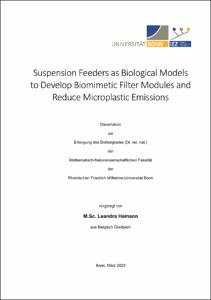Hamann, Leandra: Suspension Feeders as Biological Models to Develop Biomimetic Filter Modules and Reduce Microplastic Emissions. - Bonn, 2023. - Dissertation, Rheinische Friedrich-Wilhelms-Universität Bonn.
Online-Ausgabe in bonndoc: https://nbn-resolving.org/urn:nbn:de:hbz:5-71011
Online-Ausgabe in bonndoc: https://nbn-resolving.org/urn:nbn:de:hbz:5-71011
@phdthesis{handle:20.500.11811/10900,
urn: https://nbn-resolving.org/urn:nbn:de:hbz:5-71011,
author = {{Leandra Hamann}},
title = {Suspension Feeders as Biological Models to Develop Biomimetic Filter Modules and Reduce Microplastic Emissions},
school = {Rheinische Friedrich-Wilhelms-Universität Bonn},
year = 2023,
month = jun,
note = {With every wash cycle, microplastic fibres are released from textiles and enter the environment via the wastewater system. In order to develop an innovative washing machine filter, a biomimetic approach was employed. In biomimetics, biological working principles are analysed, abstracted models are created, and products and processes are developed that solve technical problems. The problem of microplastic release was studied for kitchen sponges by conducting a citizen science experiment. The results indicate that 58 - 355 t of microplastic particles are released annually from kitchen sponges into wastewater in Germany. The separation of microplastics from wastewater is a liquid-solid separation and the biological analogue to this was identified in suspension feeders. Suspension feeders are aquatic organisms that separate particles from the surrounding water for feeding. Within the framework of a literature study, 35 separation mechanisms were described on the basis of 18 biological and technical parameters and evaluated with regard to their biomimetic potential. Two filtration mechanisms were selected for more in-depth analysis: Mucus filtration and cross-flow filtration.
Mucus surfaces are formed by biofilms. Field and laboratory experiments showed that surfaces with biofilms absorb up to 12 times more microplastic particles than surfaces without biofilms. A biomimetic abstraction was not pursued due to the lack of technical materials that have the same particle-separating properties.
In cross-flow filtration, parallel flow is applied to the filter medium, preventing particle deposition and sebsequent clogging. In order to study this filtration mechanism, five ram-feeding fish species were selected. As ram-feeders swim forward, water flows into their mouths and food particles are retained by the gill arch system. Based on morphometric data, micro-CT scans, and behavioural experiments, three morphotypes were described that differ in terms of geometry, surface structuring, and materials. A modification of cross-flow filtration was identified as the underlying filtration mechanism, which is described for the first time as semi-cross-flow filtration. In further experiments, it was confirmed that the angle of attack of the filter medium to the fluid is decisive in semi cross-flow filtration in order to avoid the accumulation of particles. Subsequently, filter elements were created based on the conical geometry, the arrangement of the gill arches and the mesh size of the gill arch system. A filter housing generates a turbulent inflow and discharges the clean permeate and the particle-containing concentrate. Initial laboratory tests demonstrated a proof-of-concept of the biomimetic filter module that has an average filter efficiency of 97.3%.},
url = {https://hdl.handle.net/20.500.11811/10900}
}
urn: https://nbn-resolving.org/urn:nbn:de:hbz:5-71011,
author = {{Leandra Hamann}},
title = {Suspension Feeders as Biological Models to Develop Biomimetic Filter Modules and Reduce Microplastic Emissions},
school = {Rheinische Friedrich-Wilhelms-Universität Bonn},
year = 2023,
month = jun,
note = {With every wash cycle, microplastic fibres are released from textiles and enter the environment via the wastewater system. In order to develop an innovative washing machine filter, a biomimetic approach was employed. In biomimetics, biological working principles are analysed, abstracted models are created, and products and processes are developed that solve technical problems. The problem of microplastic release was studied for kitchen sponges by conducting a citizen science experiment. The results indicate that 58 - 355 t of microplastic particles are released annually from kitchen sponges into wastewater in Germany. The separation of microplastics from wastewater is a liquid-solid separation and the biological analogue to this was identified in suspension feeders. Suspension feeders are aquatic organisms that separate particles from the surrounding water for feeding. Within the framework of a literature study, 35 separation mechanisms were described on the basis of 18 biological and technical parameters and evaluated with regard to their biomimetic potential. Two filtration mechanisms were selected for more in-depth analysis: Mucus filtration and cross-flow filtration.
Mucus surfaces are formed by biofilms. Field and laboratory experiments showed that surfaces with biofilms absorb up to 12 times more microplastic particles than surfaces without biofilms. A biomimetic abstraction was not pursued due to the lack of technical materials that have the same particle-separating properties.
In cross-flow filtration, parallel flow is applied to the filter medium, preventing particle deposition and sebsequent clogging. In order to study this filtration mechanism, five ram-feeding fish species were selected. As ram-feeders swim forward, water flows into their mouths and food particles are retained by the gill arch system. Based on morphometric data, micro-CT scans, and behavioural experiments, three morphotypes were described that differ in terms of geometry, surface structuring, and materials. A modification of cross-flow filtration was identified as the underlying filtration mechanism, which is described for the first time as semi-cross-flow filtration. In further experiments, it was confirmed that the angle of attack of the filter medium to the fluid is decisive in semi cross-flow filtration in order to avoid the accumulation of particles. Subsequently, filter elements were created based on the conical geometry, the arrangement of the gill arches and the mesh size of the gill arch system. A filter housing generates a turbulent inflow and discharges the clean permeate and the particle-containing concentrate. Initial laboratory tests demonstrated a proof-of-concept of the biomimetic filter module that has an average filter efficiency of 97.3%.},
url = {https://hdl.handle.net/20.500.11811/10900}
}






